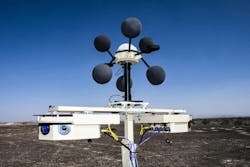Army chooses Logos to provide airborne sensors for persistent surveillance and hostile fire detection
Editor's note: this story has been updated for accuracy.
ABERDEEN PROVING GROUND, Md. – U.S. Army surveillance and reconnaissance experts needed hostile fire detection systems to pinpoint enemy hostile fire over broad areas. They found their solution from Logos Technologies LLC in Fairfax, Va.
Officials of the Army Contracting Command at Aberdeen Proving Ground, Md., announced a $19.4 million contract to Logos on Tuesday for the company's Serenity persistent surveillance systems to detect enemy fire and unmanned aerial vehicles (UAVs) from aerostats, manned and unmanned air platforms, static ground positions, and moving vehicles.
The Serenity system weighs 50 to 75 pounds, depending on the configuration, and can mount on towers, aerostats, and some aircraft. On an aerostat, Serenity can work with wide-area motion imagery (WAMI) systems to provide operators with additional near real-time and archived imagery.
WAMI is an approach to intelligence, surveillance, and reconnaissance that uses sophisticated airborne sensors to detect, image, and track every vehicle and every person moving on foot over a large designated area. The WAMI operator does not worry about losing one target while tracking another going in a different direction.
Related: Maintaining a constant reconnaissance eye
This contract asks Logos to supply, maintain, and operate deployed Serenity hostile fire detection systems, which employ dual-sensor systems to safeguard U.S. expeditionary forces against potential terrorists.
The system combines electro-optical and acoustic sensors to pinpoint the origin of heavy weapons fire and explosions from distances as far away as 6.2 miles away in any direction, with fewer false alarms than single-sensor systems.
The U.S. Army Research Laboratory is trying to reduce the size and weight of Serenity and install it on a gyrocopter as a surrogate for a UAV.
On this contract Logos will do the work in Fairfax, Va., and should be finished by February 2029. For more information contact Logos Technologies online at www.logostech.net, or the Army Contracting Command at Aberdeen Proving Ground at https://acc.army.mil/contractingcenters/acc-apg/.
